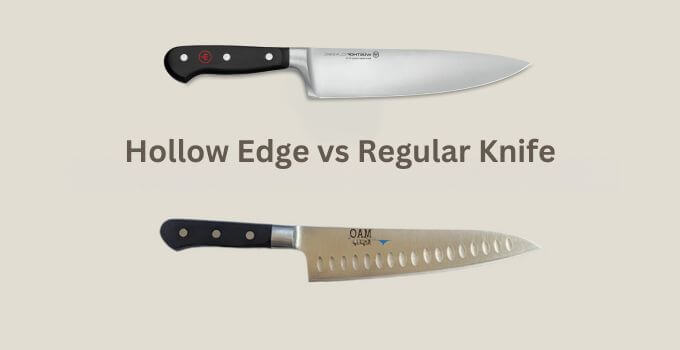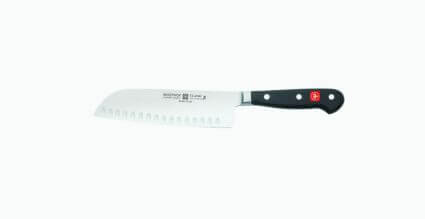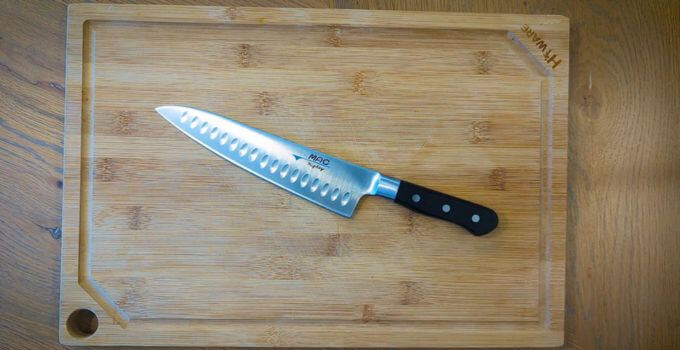
When it comes to kitchen knives, few debates are as fierce as Hollow Edge vs. Regular Knife. If you’re looking for the perfect kitchen companion, you’re probably faced with a long line of options, each promising to revolutionize your cooking experience. Yet, the truth is, while knives are essential, understanding the distinct features of hollow edge and regular knives can help you pick the right one for your specific needs.
In this guide, we’ll break down everything you need to know about hollow edge knives and regular knives, explore their advantages and disadvantages, and help you make the most informed choice.
What is a Hollow Edge Knife?
A hollow edge knife is easy to spot thanks to the small, evenly spaced indentations (often referred to as “granton edges” or “hollowed-out” sections) along the blade’s side. These divots are designed to create tiny air pockets between the blade and the food, reducing friction. This design makes hollow edge knives particularly popular for precise slicing.

If you’ve ever experienced a stubborn potato sticking to your knife mid-slice, you’ll appreciate the hollow edge’s magic. The indentations help the knife slice through food cleanly, preventing it from clinging to the blade. These knives are particularly handy for tasks that involve slicing thin or delicate items, like tomatoes, cucumbers, or even sashimi.
Regular Knives: A Timeless Classic
Regular knives, on the other hand, boast smooth blades without any indentations or divots. You’ll find regular knives in many forms, from chef’s knives to paring knives and everything in between. Because they lack the air pockets of a hollow edge, they’re better suited for chopping, dicing, and handling tougher ingredients.
Without the hollow edge design, regular knives offer a continuous, uninterrupted blade, making them ideal for cutting through harder foods like meat, cheese, or dense vegetables.

In professional kitchens, regular knives are often a go-to for their simplicity and versatility, proving effective for both precision work and brute-force chopping.
Hollow Edge vs. Regular Knife: Key Differences

Understanding the technical distinctions between hollow edge and regular knives will help you choose based on your cooking style.
Cutting Efficiency
- Hollow Edge: Thanks to the granton edge, hollow edge knives reduce resistance, allowing for cleaner slices and reducing food sticking. They’re best suited for thin slicing tasks.
- Regular Knife: While they may lack the non-stick advantage, regular knives compensate by providing a stronger, consistent blade. They’re excellent for robust tasks like chopping through thick veggies or handling meats with some resistance.
Precision and Control
- Hollow Edge: The hollow edge’s reduced friction makes it easier to control each slice, especially when handling delicate ingredients. This design is a favorite in the world of fine slicing and carving.
- Regular Knife: Without air pockets, regular knives allow for better weight distribution and balance, making them more versatile for chefs who want to go from chopping herbs to slicing meat without switching tools.
Versatility
- Hollow Edge: While brilliant for precise tasks, hollow edge knives can feel limited if you need a knife that can chop and dice with equal prowess.
- Regular Knife: These knives win the versatility round. A good regular chef’s knife can handle a wider range of ingredients, making it a better choice for multi-tasking in the kitchen.
Durability
- Hollow Edge: Due to the indentations, hollow edge knives can sometimes be more prone to chipping if not properly maintained. They require gentle care and sharpening.
- Regular Knife: With a sturdy, continuous blade, regular knives are generally more durable. They’re less likely to chip or crack under pressure, making them ideal for heavy-duty kitchen tasks.
Ease of Sharpening
- Hollow Edge: Sharpening a hollow edge knife can be a bit tricky due to the divots along the blade. It’s generally recommended to use professional sharpening services or specialized tools.
- Regular Knife: The smooth blade of a regular knife makes it easier to sharpen at home, even for beginners. With basic sharpening skills, you can keep a regular knife in peak condition without hassle.
Which Knife Should You Choose?
Ultimately, the choice boils down to your kitchen style and preferences. Are you someone who values precise, clean cuts when slicing fruits, veggies, or meats? Or do you need a knife that can handle everything from fine slicing to robust chopping?
- Go for a hollow edge knife if your priority is non-stick slicing and you frequently work with delicate or sticky ingredients.
- Stick with a regular knife if you need a reliable all-rounder that can handle both finesse and force in the kitchen.
Many professional chefs and home cooks actually find it beneficial to have both in their arsenal. With a hollow edge knife for those precise, thin slices and a regular knife for more robust chopping, you can tackle a wide variety of culinary tasks with ease.
Practical Applications: Hollow Edge vs. Regular Knife in Action
Let’s look at a few scenarios that might help you decide which knife suits your needs better.
Slicing Raw Fish for Sushi or Sashimi
- Hollow Edge: Perfect. The hollow edge ensures clean, smooth slices that won’t tear or cling to the blade.
- Regular Knife: Can still do the job, but you may encounter sticking with raw fish due to the smooth blade.
Chopping Herbs and Vegetables for Soups or Stews
- Hollow Edge: Effective, but less durable when it comes to constant chopping.
- Regular Knife: Ideal. A regular knife’s weight and strength handle repetitive chopping easily.
Carving a Roast or Turkey
- Hollow Edge: Excellent for making thin, clean slices without food sticking.
- Regular Knife: Works well but may not achieve the same smoothness, as slices can stick to the blade.
Dicing Potatoes, Carrots, or Celery
- Hollow Edge: May not hold up to the tough texture of denser vegetables.
- Regular Knife: Perfectly suited for the task, providing durability and control.
Care and Maintenance Tips for Both Knives
Regardless of your choice, taking care of your knife will prolong its life and maintain its sharpness. Here are some quick tips:
Hollow Edge: Avoid chopping hard ingredients like bones or frozen food, as it can chip the blade. Use professional sharpening services or guided sharpening tools.
Regular Knife: Regular knives are easier to sharpen, so a good whetstone or honing steel will keep your blade in great condition.
Conclusion
Whether you’re a seasoned chef or a home cook, the choice between a hollow edge and regular knife isn’t a one-size-fits-all decision.
A hollow edge knife’s non-stick ability and precision make it ideal for those who prioritize smooth, clean slicing, while a regular knife’s durability and versatility offer greater resilience for a broader range of kitchen tasks.
Consider your cooking style, the types of ingredients you use most, and whether you need fine slicing or heavy chopping capabilities.
If possible, try holding each type of knife and feeling its balance in your hand. Each knife style brings its own advantages, so you might even find that having both types in your kitchen makes cooking easier and more enjoyable.
FAQs
What is the main purpose of a hollow edge knife?
A hollow edge knife is designed primarily for reducing food sticking and achieving cleaner, precise slices. The indentations, or “hollow edges,” create air pockets that prevent food from adhering to the blade, making it ideal for slicing thin or sticky items.
Can I use a regular knife for all kitchen tasks?
Yes, a regular knife is versatile and well-suited for a variety of kitchen tasks, from chopping and slicing to dicing and mincing. However, it may not provide the same clean, non-stick slicing as a hollow edge knife for delicate or sticky foods.
Is it difficult to sharpen a hollow edge knife?
Sharpening a hollow edge knife can be challenging due to the divots along the blade. While it can be done at home, many people prefer to have hollow edge knives sharpened professionally to avoid damaging the blade.
Do hollow edge knives chip more easily than regular knives?
Hollow edge knives can be more prone to chipping due to the thinner sections of the blade created by the indentations. They require gentle care and should not be used on hard surfaces or for chopping through dense ingredients.
Which knife is better for cutting meat, a hollow edge or regular knife?
For raw meat and delicate cuts, a hollow edge knife provides clean, precise slices. However, for tougher cuts or chopping through bones, a regular knife is generally more durable and reliable.
Leave a Reply